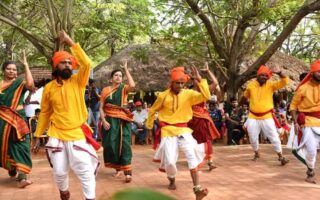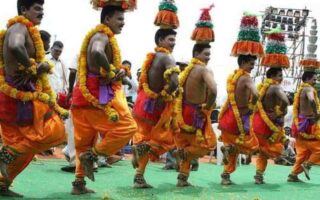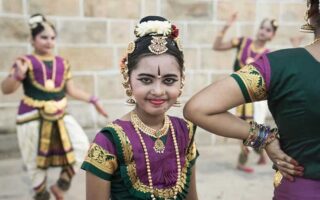- Region: Tamil Nadu, Thanjavur
- Earlier: Sadir, Daasiyattam
- Got Name After: Bharata Muni
- Primary Concepts: Raga, Bhava and Taal
Bharatanatyam dance of Tamil Nadu state is a historical dance that why it is well established. This is most famous dance form among the Indian dances; according to the sage it was originated at Thanjavur district. It is an original type of classical dance. This is a fine mixture of the Nritya and Nritta; it is a contrast combination of expression of hands, eyes with rhythm and Natya. This dance is generally accompanied by Mudras, Abhinaya and Rasa. All dance forms are connected to the Nava Rasas. Bharatanatyam dance is captured by the Carnatic music.
The name of this dance form has been come from 3 common concepts of Raga, Bhava and Tala. This dance has been inspired from the books like Abhinaya Darpanam, Natyashastra. From the time, of Tamil Nadu state’s Temples Devdasies, this dance form is called as Daasiyattam. This was one of the religious rituals and it has lengthy and snowy past. The prince and king’s courts have been supported the temples also the different maintained dance forms. According to sage, Bharatanatyam dance got its name from the ancient Bharata Muni, this great sage is an author of Natya Shastra. He wrote this during the second century BC till second century AD. From that time, this dance is known as Sadir. The 4 brothers Sivanandam, Ponniah, Chinnaiah and Vadivelu are combined popular as Tanjore Quartet converted the current Bharatanatyam dance. The compositions of there are still in use for forming the dance today also. Nattuvanars means male gurus were providing the training. This was a moment when Tamil Nadu state’s art got the unbelievable encouragement; during that the artists were getting the priceless gifts and land and also the high esteem.

In ancient time, the Mughal Empire started to demolish the temple dancing activity. The rulers of Mughal dynasty brought numbers of performers from the Persian states. The Devdasis were not getting the support and numbers of Devdasis were started to learn the Persian dance. From the Kings and Princes the British rule was away. Many anxious dancers have started earning and stopped to getting the any kind of support to behave similar to prostitution. Due to that the pure and magnificent Bharatanatyam dance fell in the disgrace. Since then the girls of royal families didn’t show interest learning the Bharatanatyam dance; they were started assuming the dance as a low class profession, this was happened in the ending of nineteenth century and also the twentieth century’s start.
Again the Bharatanatyam dance form became active because of the patronage of dancers and activities such as E. Krishna Iyer & Rukmini Devi. She had established the institution known as Kalakshetra during the year of 1936. From that time, the trend of reform was spread everywhere. At present, numbers of universities are serving the degree education in the Bharatanatyam dance; many students got the honors and recognition internationally. Within Bharatanatyam dance, the performance gets spread in high speed and it became more beautiful. Currently, there are countless female and male dances in the entire India, who have taken this art outside the border of India.
Bharatanatyam dance of Tamil Nadu contains around 3 elements, Abhinaya is displayed by performer through the body movements, Nritta, is a pure dance and Alarippu etc. the Nritya element contains expression and also Nritta. Dancing movements of Bharatanatyam go with the rhythm and also they do the movements with Abhinaya means acting e.g Shabdama, Varnam etc. Natya element includes dramatic factors; here the dancer becomes the story character, like a drama’s character such as Ramayana. You can find the difference between the Natya and Nritya, in the Nritya where the dancer plays particular character and act. At the same time, the dancer can also act the 2 characters. Within the Natya, the dancer gets converted into the character just by dressing the jewellery and costumes as per the personality of the character. In Bharatanatyam, the rhythmic movements of body with beautiful gestures of hand are known as Adavus. The mixture of Adavus is known a s Korvai. Generally Korvai gets over with Theermanam. This is a Thadiginathom Adavu or Kitathakadharikitatom practiced in multiples.
The basic Adavu are sixty-four and it has been separated in the nine sections like Kuthithumettadavu, Naatadavu, Sarikkal, Mandiadavu and Thattumettu all these are very essential. The dancers communicate the story through the Hasta Mudras and Bhavabhinaya. As per the ritual, they always begin the performance by prayer of Ganapathi God and they also praise the Nataraja Moorthi. Bharatanatyam dance performance’s sequence is Jathiswaram, Padam, Alarippu, Varnam, Thillana and Sabdam. Later on Thillana, by the Mangala Slokam the performance gets over. Generally the duration of the performance is 2 or 2 ½ hours.
Dance Forms
Jathiswaram

It is one of the expressions of Bharatanatyam dance, to show the impressions and ideas, which have been created by the rhythmic sound, performer’s uses this expression. This rhythm is one rhythm among the other 5 beats or Jethis, it might be three, four, five, seven or nine. The timekeeper measures the beats through his cymbals or Talas, where as drum player generates the various types of amazing and energetic sounds. The performer attaches the tempo to his feet by keeping the rhythm in Talas. The prime impact of numbers is pleasant atmosphere of sounds. In the ending dancing movements the performer showcases the delicate nuances or swarams all these are delightful in the technique of Pillay depend on Chakravakam, Bhairavi, Sankarabharanam and Vasanta ragas.
Varnam

In all dance forms of Tamil Nadu state, Varnam is a lengthiest. In the form, both elements like Abhinaya and Nritya contains equal portion. The prevalent theme of Varnam is Love. The dance gets over on an enraged tempo along with immediately changing types of feet and speedy Thirmanams. Varnam form consist 3 famous varieties such as Kalyani Varnam, Todi Varnam and Ragamalika Varnam. The performer begins by low tempo, considering the pose’s series, the movements get changed slowly. Later on the Thirmanams of performer’s hands become faster, at the end the Nritta gets over afterwards the numbers of bends and leaps over 3 pronounced musical beats. Later on the Abhinaya part follows the Varnam. Through the Abhinaya, they try to display the one theme but by different ways as per the Sanchari Bhava. The variety of Sanchari Bhava or Samcari spread the pleasant on the whole Varnam. For the performance of Varnam they use the songs of Jayadev, Arunacalakavi, Thyagaraja and Kshetrajna.
Alarippu

Every performance of Bharatanatyam dance starts by Alarippu. Alarippu name has been existed from the Telegu language called as Alarimpu, meaning of this word is adorned by flowers. This is a pure Nrita, which serves as treble and double rhythm. The major requirement of this dance is concord between the movements of hands, head and feet. The hands of the performer get attached with the head, touches the head, the performer starts the dance by neck movements or Rechekas with eyes. After that the similar Rechekas practiced in the semi seated position.
Padams

The songs which represents imitate are called as Padmas. The performance of Padam, the performer showcases the story of lovers in the different poses. Numbers of renowned music composer such as Jayadevan, Kshetrajna, Swathi Thirunal, Gopalakrishna and Irayimman Thampi etc have created the Padams, this gives a grace and glow to the dance performance. Generally around 3 to 4 Padams are practiced over the stage.
Music
The Bharatanatyam dance’s music is actually inspired by the Carnatic classical dance. The prime musical instruments in the Bharat Natyam dance are cymbal pairs and Mridangam. On few times, Violin, Veena, Flute and Ghatam are also practiced by the musicians for this dance form. The cymbal’s pair creates timing, during the sound of Mridangam provides incomplete measures. The direction of the dance is done through the Nattuvanar, this gives the Thaalam by the help of hand symbols and performing the Vaaythari. There is always 2 additional singers. The Bharatanatyam dancer always follows the cymbals and Mridangam. Another musical instrument called Tambura is always used in orchestra to offer Swara.
Accessories
To make the performance eye pleasant and attractive the performers wear lots of jewellery. They wear the glowing stones on hands, neck, head and ears, Jasmine garland within the foot, which also contains the tiny bells. Around the bun, the female dancers wear the flowers in circular shape or Veni in the hair. On the center point of forehead women wear the Tika. The very common jewellery items are Rakodi, Thalaisaman, they wear it over the flowers and Chadrasuryan on both sides. The ornament of ear includes 3 pieces Jhumki, Maatal and Thodu, this fits on lobe. To decorate the neck, they usually wear Adigai, it contains pendant and choker and big chain along with long Padakkam in green, red and stone with floral or peacock designs. In the upper arm, they wear the Vanki means undulating bangle, in wrist golden bangles, broad ornaments or Odyanam and on special occasion they wear Sarpam ornament to adorn the lengthy plait. Majority of Bharat Natyam dancers of entire India demand the jewellery from Tamil Nadu state’s Nagercoil and Mylapore, these two centers have numbers of brilliant gold smiths.
Costumes
The attire of the Bharatanatyam dancers is one of the prime attractive elements of their performance. Their attire contains Dhoti or Paijama and Kanchipuram silk jacket and important Banaras silk. The Banaras silk saree is considered as very much rich and royal because of its detail embroidery work and dazzling silk. They wear the till the ankles and on the legs they specially makes the plates of saree. The female dancers wear Choli of tight fitting. The male dancer generally keep the upper part of the body open, they only wear the necklace in ornaments.
Modern Bharatanatyam
The modern type of Bharatanatyam became systematic due to famous Thanjavur Brothers, Sivanandam, Chinnayya and Vadivelu. The modern look of the Bharat Natyam dance is like a management of 4 Nattuvans.


